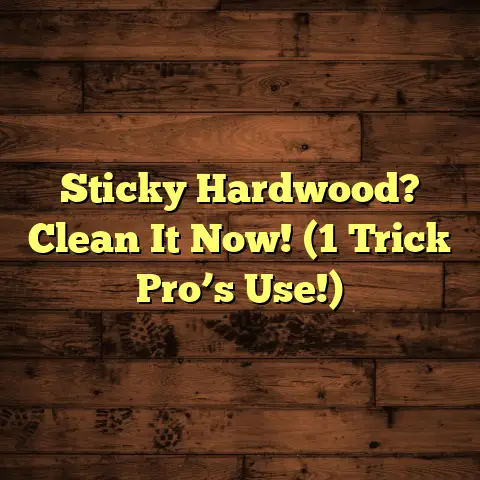How To Restore Old Hardwood Floors? (Explained)
Restoring old hardwood floors is an endeavor that can transform the look and feel of your home. I’ve had the pleasure (and sometimes the frustration) of restoring several hardwood floors, and through these experiences, I’ve learned a great deal about the process. In this comprehensive guide, I’ll share everything I’ve learned about restoring hardwood floors, including detailed steps, costs, challenges, and tips to ensure your project is a success.
Understanding Hardwood Floor Restoration
Hardwood floor restoration is the process of bringing back the beauty and functionality of aging or damaged hardwood floors. Over time, floors can become scratched, dull, or discolored due to foot traffic, furniture movement, and environmental factors. My living room floors were a classic example of this degradation. They were once a beautiful oak wood but had become lifeless and had numerous scratches from years of wear.
Why Restore Instead of Replace?
Restoration can often be more cost-effective than replacing your floors entirely. Replacing hardwood floors can cost anywhere from $8 to $15 per square foot, which quickly adds up depending on the size of your space. In contrast, restoring existing hardwood can cost around $3 to $5 per square foot, making it a more budget-friendly option. Additionally, restoring allows you to keep the original charm and character of your home.
Assessing the Condition of Your Floors
Before diving into the restoration process, it’s crucial to assess the condition of your hardwood floors. Here’s how I approached this step:
Visual Inspection
I began with a thorough visual inspection of my hardwood floors. I looked for:
- Scratches and Dents: Minor scratches can often be buffed out, while deeper dents may require sanding.
- Finish Wear: Areas where the finish had worn away were apparent, often showing signs of dryness or discoloration.
- Water Damage: I checked for any water stains or warping, which could indicate more serious issues.
Testing the Finish
To determine whether my floors needed a full sanding or just a screen and coat (a lighter approach), I conducted a simple test. I applied a few drops of water to the surface. If it beaded up, the finish was still intact; if it soaked in, it was time for a full restoration. In my case, the water soaked in—an indicator that my floors needed significant work.
Gathering Tools and Materials
With a clear understanding of what I was dealing with, I set out to gather the necessary tools and materials for the restoration project. Here’s a comprehensive list:
Tools
- Drum Sander: Essential for removing the old finish and sanding down to bare wood. I rented one from a local hardware store for about $50 per day.
- Orbital Sander: Useful for detail work and smoothing edges.
- Floor Buffer: This was necessary for applying the final finish evenly.
- Vacuum Cleaner: A powerful vacuum is crucial for cleaning up dust after sanding.
- Paint Brushes and Foam Applicators: For applying stain and finish.
Materials
- Sandpaper: Various grits (36, 60, 80, 120, 220) were essential for different stages of the sanding process.
- Stain: I chose a dark walnut stain that cost around $30 for a quart.
- Finish: A water-based polyurethane finish was my choice for durability, costing about $60 for a gallon.
- Wood Filler: This helped fill in deeper scratches and dents before sanding.
The Restoration Process
Step 1: Preparing the Area
Preparation is key to any successful restoration project. Here’s how I prepared my space:
- Remove Furniture: I cleared out all furniture from the rooms where I would be working. This took about two hours but was crucial to ensure I had enough space to work without obstacles.
- Cover Vents and Doorways: To minimize dust spread, I covered vents and doorways with plastic sheeting. This simple step saved me hours of cleaning later on.
- Clean the Floors: Before sanding, I swept and vacuumed thoroughly to remove any dirt or debris that could scratch the wood during the sanding process.
Step 2: Sanding the Floors
Sanding is arguably the most labor-intensive part of the restoration process. Here’s how I approached it:
- Start with Coarse Grit Sandpaper: I began with 36-grit sandpaper on my drum sander to remove the old finish. It’s important to keep the sander moving in a straight line to avoid creating gouges in the wood. Each room took about four hours to sand completely.
- Progress Through Grits: After the initial sanding, I switched to 60-grit paper and then 80-grit to smooth out any rough spots. Finally, I used 120-grit sandpaper for a finer finish. The entire sanding process took around two days for my living room and dining area.
- Detail Work: For corners and edges that my drum sander couldn’t reach, I used an orbital sander with finer grit paper. This part required patience but was necessary for a complete job.
- Cleaning Up After Sanding: Once sanding was complete, I vacuumed thoroughly again and wiped down the floors with a damp cloth to remove all dust particles.
Step 3: Staining
After ensuring my floors were clean and smooth, it was time to apply stain:
- Choosing Stain Color: I opted for dark walnut to give my oak floors a rich appearance. Always test your stain on a small area first; this helps avoid any surprises later on.
- Application Technique: Using a foam applicator, I worked in small sections (about 4’x4’) and applied an even coat of stain. The key is to avoid over-applying; too much stain can lead to uneven color.
- Drying Time: After applying the first coat, I waited about eight hours before applying a second coat. I was thrilled with how deep and rich the color looked after two coats.
Step 4: Finishing
Finishing is crucial for protecting your newly stained floors:
- Choosing Your Finish: I decided on a water-based polyurethane because it dries clear and minimizes yellowing over time.
- Applying the Finish: Using a clean paint roller, I applied the first coat of finish evenly across the floor. I made sure to work quickly but carefully to avoid bubbles.
- Multiple Coats: I applied three coats of finish total, allowing each coat to dry for about two hours before applying the next one.
- Final Buffing: After the last coat dried completely (around 24 hours), I gave the floors a light buffing with an orbital buffer to ensure an even sheen.
Challenges Faced During Restoration
While restoring my hardwood floors was rewarding, it wasn’t without its challenges:
Uneven Surfaces
Some areas required extra sanding due to uneven wear from previous use. In one corner of my living room, I encountered deeper scratches that needed attention. I spent an additional couple of hours focused on those areas with finer grit sandpaper.
Color Matching
Getting an even stain color proved tricky at times. There were spots where the wood absorbed more stain than others, leading to uneven patches. To remedy this, I learned that applying stain in smaller sections allowed me to blend more effectively without letting it dry too quickly.
Drying Times
The waiting game was perhaps the hardest part of this project for me. Waiting for finishes to dry tested my patience multiple times throughout the process. To speed things up slightly, I kept windows open for ventilation but ensured that temperatures remained stable.
Comparing Different Approaches
Throughout my flooring restoration journey, I’ve considered various options for achieving beautiful results:
- Professional Refinishing: Hiring professionals could have saved time but would have cost around $3 to $5 per square foot for labor alone—adding up quickly if you have several rooms like I did.
- Screening and Coating: This method involves lightly sanding without fully removing the old finish before applying new polyurethane. It’s quicker but doesn’t address deeper scratches or stains as effectively as full restoration does.
- DIY vs Professional Help: While DIY projects often save money, they require time and effort. For those who aren’t comfortable with tools or don’t have time to devote to such projects, hiring professionals might be worth considering despite the costs involved.
Maintenance Tips
After going through the process of restoring my hardwood floors, it became clear that maintaining them is just as important as restoring them:
- Regular Cleaning: Sweeping or vacuuming regularly helps prevent dirt buildup that can scratch surfaces over time.
- Protective Pads: Placing felt pads under furniture legs prevents scratches when moving items around.
- Avoid Water Overexposure: Moisture can damage wood over time; therefore, mopping with excessive water should be avoided.
- Reapply Finish Every Few Years: Depending on foot traffic levels in your home, consider reapplying a coat of polyurethane every few years to maintain protection against wear.
Conclusion
Restoring old hardwood floors is not just about aesthetics; it’s about preserving history and enhancing your home’s value while enjoying newfound longevity from your existing materials. My experience taught me valuable lessons about preparation, technique, and finishing touches that matter significantly in achieving stunning results.
If you’re considering taking on this project yourself or hiring professionals instead weigh your options carefully based on skill level and budget constraints—each approach has its merits that could cater specifically toward individual needs! Whether you choose DIY or professional help ultimately leads back down one path—the satisfaction derived from having beautiful restored hardwood floors will surely enhance any living space!





